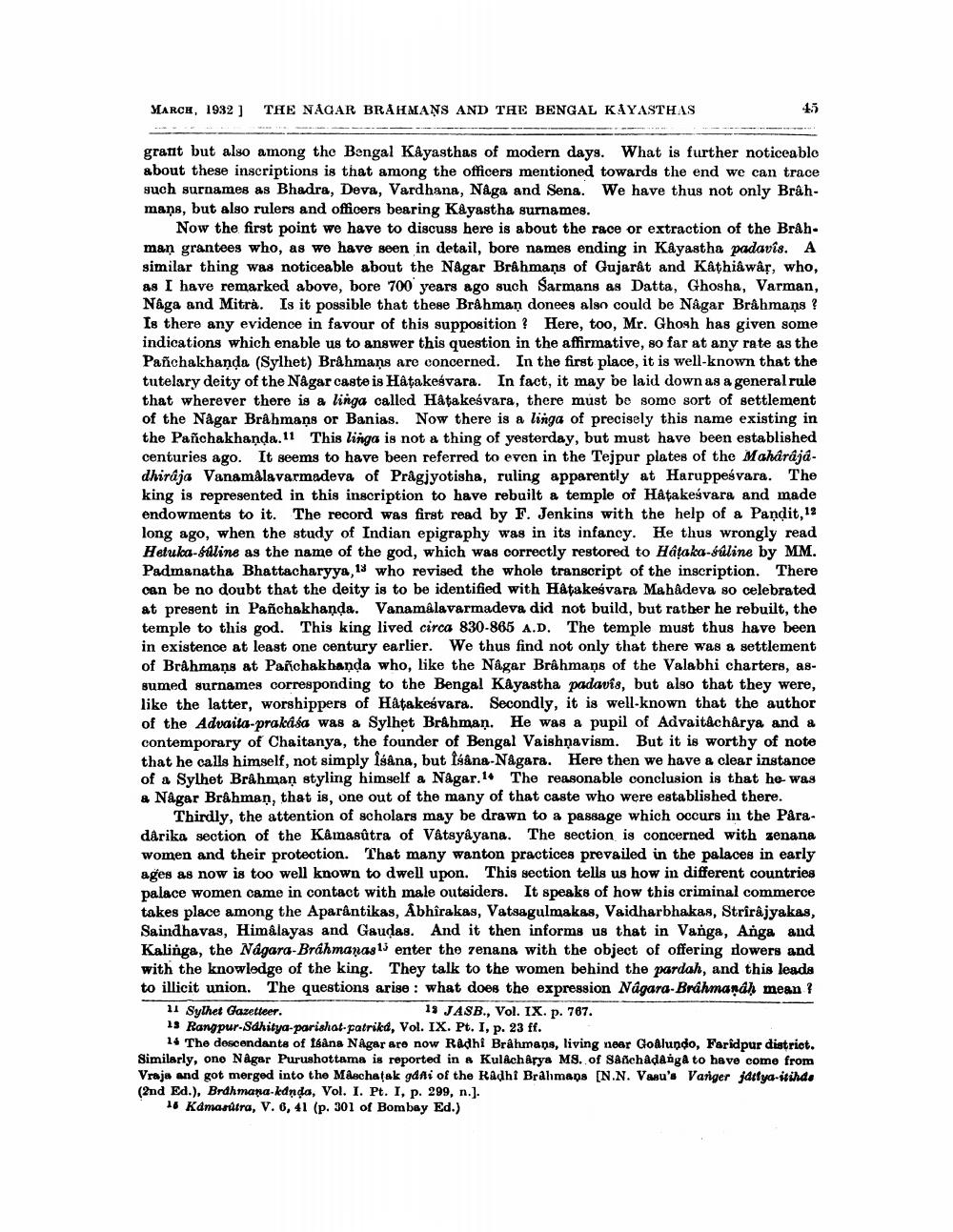________________
MARCH, 1932 ] THE NAGAR BRAHMANS AND THE BENGAL KAYASTHAS
grant but also among the Bengal Kayasthas of modern days. What is further noticeable about these inscriptions is that among the officers mentioned towards the end we can trace such surnames as Bhadra, Deva, Vardhana, Naga and Sena. We have thus not only Brahmans, but also rulers and officers bearing Kayastha surnames.
Now the first point we have to discuss here is about the race or extraction of the Brahman grantees who, as we have seen in detail, bore names ending in Kayastha padavis. A similar thing was noticeable about the Nagar Brâhmans of Gujarat and Kathiâwâr, who, as I have remarked above, bore 700 years ago such Sarmans as Datta, Ghosha, Varman, Någa and Mitrà. Is it possible that these Bråhmaņ donees also could be Någar Brâhmans? Is there any evidence in favour of this supposition ? Here, too, Mr. Ghosh has given some indications which enable us to answer this question in the affirmative, so far at any rate as the Panchakhanda (Sylhet) Brahmans are concerned. In the first place, it is well-known that the tutelary deity of the Nagar caste is Hatakesvara. In fact, it may be laid down as a general rule that wherever there is a linga called Hâţakeśvara, there must be some sort of settlement of the Nagar Brâhmans or Banias. Now there is a linga of precisely this name existing in the Panchakhanda 11 This linga is not a thing of yesterday, but must have been established centuries ago. It seems to have been referred to even in the Tejpur plates of the Maharaja - dhiraja Vanamálavarmadeva of Pragjyotisha, ruling apparently at Haruppeśvara. The king is represented in this inscription to have rebuilt a temple of HAtakeśvara and made endowments to it. The record was first read by F. Jenkins with the help of a Pandit, 12 long ago, when the study of Indian epigraphy was in its infancy. He thus wrongly read Hetuka-suline as the name of the god, which was correctly restored to Hataka-súline by MM. Padmanatha Bhattacharyya, 13 who revised the whole transcript of the inscription. There can be no doubt that the deity is to be identified with Hatakesvara Mahadeva so celebrated at present in Pañchakhanda. Vanamalavarmadeva did not build, but rather he rebuilt, the temple to this god. This king lived circa 830-865 A.D. The temple must thus have been in existence at least one century earlier. We thus find not only that there was a settlement of Brahmaņs at Panchakhanda who, like the Någar Brâhmans of the Valabhi charters, assumed surnames corresponding to the Bengal Kayastha padavis, but also that they were, like the latter, worshippers of Hatakeávara. Secondly, it is well-known that the author of the Advaita-prakasa was a Sylhet Brahman. He was a pupil of Advaitâchårya and a contemporary of Chaitanya, the founder of Bengal Vaishnavism. But it is worthy of note that he calls himself, not simply sana, but Isana-Någara. Here then we have a clear instance of a Sylhet Brahman styling himself a Någar. 1* The reasonable conclusion is that he was a Nagar Brahman, that is, one out of the many of that caste who were established there.
Thirdly, the attention of scholars may be drawn to a passage which occurs in the Påradarika section of the Kámasútra of Vâtsyâyana. The section is concerned with zenana women and their protection. That many wanton practices prevailed in the palaces in early ages as now is too well known to dwell upon. This section tells us how in different countries palace women came in contact with male outsiders. It speaks of how this criminal commerce takes place among the Aparântikas, Abhîrakas, Vatsagulmakas, Vaidharbhakas, Strirajyakas, Saindhavas, Himalayas and Gaudas. And it then informs us that in Vanga, Anga and Kalinga, the Nagara-Brahmanas 15 enter the zenana with the object of offering flowers and with the knowledge of the king. They talk to the women behind the pardah, and this leads to illicit union. The questions arise : what does the expression Någara-Brahmanah mean? 11 Sylhet Gazetteer.
13 JASB., Vol. IX. p. 767. 19 Rangpur-Sahitya-parishat-patrikd, Vol. IX. Pt. I, p. 23 ff.
14 The descendants of tâna Nagar aro now Radhi Brahmans, living near Goalundo, Faridpur district. Similarly, ono Nagar Purushottama is reported in Kulacharya Ms. of Sanchadanga to have come from Vraja and got merged into the Maachatak gdAi of the Radhi Brahmans [N.N. Vasu's Vanger jattya-itindo (2nd Ed.), Brdhmana-kdnda, Vol. I. Pt. I, p. 299, n.).
16 Kamasutra, V. 6, 41 (p. 301 of Bombay Ed.)




